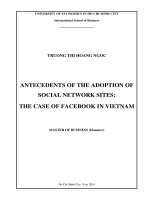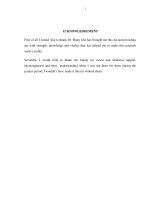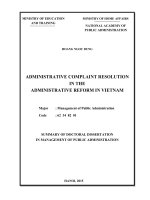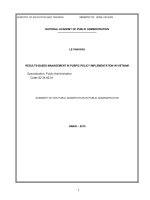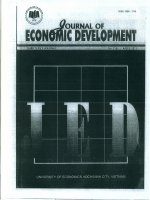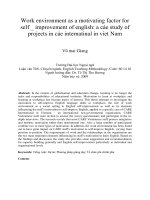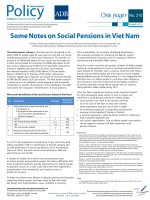Consumer behavior in groupon business in viet nam
Bạn đang xem bản rút gọn của tài liệu. Xem và tải ngay bản đầy đủ của tài liệu tại đây (12.55 MB, 16 trang )
,
.
':
~
ISS~I
1859 -
1116-
;
,.'.;
~
.
\
ISSN 1859 -1116
. . .
~2. Paulus Kurniawan, Kembar Sri Budhl, Suyana Utama& Mahaendra Vasa,
',:
.1mpacts of Coal Railroad Transportation. Project on GDP Promotion and
Unemployment Reduction in BengkultJ Province, Indonesia
" 25"! Ng!Jyen Th] Oanh,
Comparing the-Business Performance of the State-OWned
Enterprises and Others
i· .
41 ••Phung Xuan Nha & Pham Xuan Hoan,
Return on "Investment in Tertiary
Education and Tuition Policy in Vietnam
540 Tran Th] Hai Ly &-Huynh Nqoc Thuonq,
Dispositon Effect - Evidence from
Vietnamese kldividuial Investors
68.
Bui Thanh Trang &.
Ho
xuan Tien,
Factors Affecting Logistics Providers'
Satisfaction with Logistlc'Environment in Ho Chi Minh City . '.•.
'l.'- .
84. Ha Nam Khanh Giao& Nguyen Hoal
PhlJdng,-Consume'-'$~h~·vior. in .'.
"Groupon" Business
in
Vietnam . .'. ',':~;' "
960 Ngo Th]
HalXuan,
The Trans-Pacific Partnership Agreement:,Opp~rlunities
and Challenges to' Vietnam's Apperet Exported to the US Market
'108.
Tran
Tien Khai,
Interrelation BetWeen Livelihood Assets and Poverty in
Rural
vietnem . .
131'. Le Dang Lang,
Impacts of Advertising and Sales Promotion on Brand
Equity of Soft Drinks
146. Nguyen Ouynh Hoa
&
Nguyen Thach,
Mass Appraisal of Land Value
" . by Regression Model
{l~:,
,
t.
Letters and articles, please send to
£)ao Thj Minh Huy~n ' '.' •.
Journal of Economic: Development .
~9C Nguy~n £)lnh Chi~u, District 3, Ho Chf Minh. City, Vietnam.
Tel: ~8295635 - 22413173 - FaX: 84.8:38295635 .
Email:
.Publication Jj·c nce No.;2421GP-BVHTT dated May 8', 200t granted by the Ministry of Culture
and
Informati~
Price: VND 60,000 .
8~ / Hi!Nam Khanh Giao] 84 - 95
Consumer Behavior in "Groupon" Business
Consumer Behavior in
66G:roupon~~
Business in
Vietnam
HA NAMKHANH GIAO
Associate Professor, Doctor of Philosophy, University of Finance and Marketing.
Email:
NGUYEN HOA! PHl10NG
Master of Business Administration, San Ha Technique JSC
Email: -goldenchancerggmail.com
ABSTRACT
This research aims to identify thefactors that influence online shopping behavior of
consumers in
"Groupon"
busi~ess in Vietnam. The results' pr!/vide information to
determine the importance levelofeach selectedfactors andfindout the most important
jactor among these proposedfactors. Multiple Linear Regression and One-Way
ANOVA method are used. The results indicate three factors that .have impacts on
online shopping in Groupon. business: Perceived benefit in Price, . Trust and
.Convenience.
nze·
research results also point out there are no differences in attitude
toward online shopping in Groupon business between gender, education and age
group.
Keywords: Groupon, e-commerce, online business, consumer behavior, online
shopping.
I
l
I
,
-,
I .
!"
i
j .
\
JED No.216 April 2013
I
85
1. ]INTRODUCTION
During the past decade, consumers around the world are turning to the Internet for
their shopping needs and concerns. According the research of Miniwatts Marketing
Group, about two billion people worldwide have been using the Internet. As many
researchers indicated, more Internet usage results in more potential online purchases.
Recently, there have been many stories about the success of doing business on Internet
such as Google.corn, Facebook.com, Twitter.com, Ebay.com, and Amazon.com, etc.
During the economic crisis in
2008-2009,
a seminalbusiness model in e-comrnerce
sector was introduced in the USA ona deal-of-the-day website named "Groupon.com".
Consumers sign up a d~al in the website with high discount rate
(30%-90%).
If. a
certain number of people register to buy a deal on the website, then that deal becomes
available to them; if the number of sold vouchers does not reach the predetermined
number as commitment between a merchant and a website owner, no one has the deal
that day. This business model reduces risk for retailers who can use' the couporis as
quantity discounts as well as sales promotion tools. "Groupon" site makes money by
getting a share of the deal from the retailers. The idea of this e-col1lmerce website and
. . 'w : "
its business model ,is quite simple but brings about big successes. Known as a project
in which the firm's value reaches one billion dollars in sales faster than any other
business until now, this business model attracts huge investments and has developed
very fast in many countries.
With minimal barriers to entry, "Groupon" business was copied and applied all over
the world. From the middle ofthe year
2010,
several similar websites were built in
Vietnam, for example, cungmua.com.nhommua.com, doimua.com, and muachung.v~,
etc. Until the present research finished in August
2011,
there were more than
50
cloned
"Groupon" sites. In Vietnam, the "Groupon" business model has its own advantages
such as competitive prices, new produf( information channel for consumers,
advertisingchannel for small and medium companies, shops or restaurants. It is clear
that many'competitors appeared nearly at the same time in Vietnam. As a result, the
market is much more competitive when the companies start their business as
"Groupon" model.
2. LITERATURE REVIEW
According to MORl
(2001),
the level of e-shopping is related much to Internet
accessibility. Consumers who are not able to access the Internet can hardly be
e-
\
861 Ha Nam Khanh Giao] 84 - 95
Consumer Behavior in "Groupon" Business
shoppers. Brengman et al. (2005) believe that Internet usage is a decisive factor in
recognition of online consumers; therefore, they are segmented through recognition of
Internet-usage style. In addition, e-shopping awareness is another factor that influences
e-shopping. Consumers who are well aware of advantages of Internet and have high
level of Internet use are really potential e-shoppers.
Engel et al. (2001) pointed out that social influence plays an important role in
affecting consumers' online purchasing decisions. Social-cultural influences come
from family, friends, age group, and culture. Websitescan serve as social tools
enabling consumers to set up connections. In addition, online communities enable
consumers to socialize and interact further facilitating the exchange of information.
Price is clearly the important factor in both online and offline shopping, especially
in the case where selling price is much lower than usual. Customers consider the price
of product
to-
be higher or lower in comparison with the internal standards (Dodd et al.
1991). This also implies that the perceived product price affects consumer's choice and
evaluation rather than actual price.
After comparing traditional shopping with onlineone, Monsuwdet al. (2004) found
that online shopping is a more convenient way of shopping. From the Internet, lots of
product/serviceinformation can be gathered for consumer consideration with little
effort, inconvenience, and required time. Monsuwe et al. (2004) concluded that
convenience factor is really relevant to the identification of online consumers.
Consumers' trust in online shopping and prior experience with online shopping
were identified as having a significant impact on consumers' intention to do e-
shopping. Smith and Rupp (2003) found that trust, security, and prior experiences are
important factors to e-shoppers.
Smith andRupp (2003) found some faNprs influencing online buying behavior.
This process comprises three stages: (1) Operational input, (2) Process, and (3) Output.
In the first stage, the consumer is influenced by the marketing efforts made by the
.
media and the socio-cultural influences. For the process stage, it identifies and explains
how the consumer makes the buying decision online. We divided the factors into two
groups: (1) factors related to consumer: Internet
-usage
and e-shopping awareness,
demographics, attitude and belief, personal characteristics, and psychological
cha~?!eri~!ics; and (2) factors related to the website: Web experience, price of
.product! service, convenience of online shopping, and trust in online shopping. In this
\
JED No.216 April 2013/87
stage, price, convenience and trust-are main determinants for the consumer's intention
to shop online. The last stage is identified as the output stage, which is a post-purchase
decision process. By examining various studies the author has identified certain factors
that were constantly present in the literature. Hence, a conceptual framework was
developed (Figure 1) from the aforementioned discussion.
!
;
I
•
r
f -
f
t
f
I
I
I
I
r
Price
Trust
.
Convenience
Behavior intention to
Reference group
•
use onli~ s-hopping in
7'
"Groupon" business
model
Online shopping -
experience
Consumer
characteristics
':
- Age
_;4f>_t:,
- Gender
_.
-
-
Income
,
Figure 1: Conceptual Framework
,
Source: Adapted from consumer decision-making model for online shopping behavior, Smith and
Rupp,2003 .
\
88
I
Ha Nam Khanh Giao] 84 - 95
Consumer Behavior in "Group on" Business
3. METHODOLOGY
This research was.conducted by deductive approach. Firstly the theory is presented
from general- to specific levels, then questionnaires are distributed and collected
primary data are ana.lyzed. Frequency distribution of the respondents was carried out
according to questions related to demographic and webographics attributes. Multiple
regressions and analysis of variance (ANOYA) were conducted. Multiple regression
method is used to estimate the unknown value of variables- also called as the
predictors, including: Online Shopping Experience, Reference Group, Price, Trust, and
Convenience factors. ANOY A method is used to find any differences in attitude
toward online shopping intention between groups of Age, Education, and Gender. The
analysis enables us to examine the individual relationship between the independent
variables and attitude toward shopping in "Groupon" business.
4. RESULT AND DATA ANALYSIS
Due to the purpose of this research, only the questionnaire method is suitable to the
topic and able to collect the answers in a satisfactory manner. Questionnaire for
consumer survey was processed in two steps.
Firstly.,
10 friends who have knowledge
of the Groupon .were interviewed directly for the purpose of understanding the testing
survey. Secondly, questionnaire was adjusted and issued officially. The survey was
carried out on Google Docs tool and interviewees were invited. by email, then the
collected raw data would be analyzed by SPSS. The survey collected 209 valid
responses out of total 221 respondents' answers, 12 responses .were rejected because
the respondents did not complete the questionnaires. The demographics of respondents
are presented in Table 1.
Table 1: An,alysis of Demographic Factors by Using Frequency and Percentage.
Demographics
f:;~.Frequency
Percentage
, Gender
Male
Female
81
102
44.3
55.7
Age
16-22
23-28
29-34
>35
13
i
114
47
9
7.1
62.3
25.7
4.9
\
JED No.216 April 2013
I
89
Education High school or lower 15
8.2
Colleges 5
2.7
Bachelor degree 153
83.6
Master or higher 10
5.5
The reliability of a measure indicates the stability and consistency with which the
instrument measures the concept. All constructs were tested for the consistency and
reliability of the items within the constructs by using the Cronbach's alpha reliability
i :
analysis. About the reliability test results in Table 2, Cronbach's alpha of over 0.6 and
all corrected item-total correlations of over 0.3 are required for all factors in the
research (Hair et al. 1998). Cronbach's alpha for the constructs ranged from the lowest
of.0.621 to 0.784. The results showed that the Cronbach's alpha for all the constructs
used in this research exceeded the preferable scores of 0.60 and this indicated that the
measurement scales of the constructs.were stable and consistent.
. .
Factor analysis confirmed that the construct validity measurement, which was
adopted in this research, could be performed adequately (Cavana etal. 2001). Table 2
presents the detail results of this analysis. From the output, the valulof Kaiser-Meyer-
Olkin (0.684) was above the recommended level of 0.5 {between 0.5 and 1.0),
implying the factor analysis was appropriate. The statistical test for Bartlett's test of
sphericity was significant (p
=
0.000) for all the correlations among selected variable
within a correlation matrix. Based on the principal components analysis and the most
popular procedure in orthogonalrotation (VARIMAX), the output also implied that the
Eigen criteria values for all the factors were more -than 1.0. As the result of convergent
validity, the factor loadings for all items in the research were greater than 0.6.
Discriminant validity pointed out that all constructs were completely different from
~
,.
each other. In consequence, the items
wel~
not overlapping, and the respective
, 'l1·.
constructs were supported.!
\
90
I
Ha Nam
Khanb
Giao] 84 - 95 Consumer Behavior in "Groupon" Business
Table 2: Factors Identified by the Principal Components Factor Analysis
Factor's
Name
Trust
Convenience
Online
shopping' .'
.
.
expenence
Reference
group
My private information is 0.786
protected.
My friends influence my
intention in shopping 10 0.810
"Groupon" business model.
Variable
Voucher delivery is on time.
Trading transaction is
correct.
Quick response to my
question or complaint.
'Quality of product is the
same as description in the
website.
I find it easy to look for and
compare product
information.
I can purchase from the
"Groupon" websites anytime
in day.
I find it less strained when
purchasing in "Group on"
model compared to other
places.
I have experience in online
shopping.
My previous experience in
online shopping in
"Groupon" business model
has gone well.
Factor
loading
0.777
0.729
0.708
0.63.4
0.838
0.790
0.631
0.840
Eigenvalue
2.922
2.430
1.810
1.407
Percentage
of
Variance
Explained
19.481
16.168
12.064
9.382
Cronbach's
Reliability
Coefficients
0.784
0.712
: 0.718
,
-
\
0.621
\
JED No.216 April 2013191
My
relatives influence my
intention
in
shopping
in
0.795
"Groupon" business model.
Online discussions in group
0.635
or forums
influence my
intention In shopping in
"Group on" business model.
I
find it important to save 0.838
Price
money in shopping.
1.254
8.359
0.622
I
save money in shopping in
0.796
"Groupon" business model.
Note: KMO Measure of Sampling Adequacy = 0.684; p = 0.000 (p<0.05); df= 105.
Cumulative Percentage Rotation Sums of Squared Loadings
=
65.485
TableB shows the result of regression analysis, the "Benefit in price" impacts
positively on consumer purchase intention in "Groupon" business model, as p value
(.001) is less than 0.05. "Trust" (sig.
=
.000) and "Convenience" (sig.
=
.000) are also
.
,
significant predictors.
Table 3: Coefficient of Multiple Linear Regression Model for Attitude towards
Online Shopping in "Groupon" Business
Coefficients
Unstandardized Standardized
Correlations
coefficients
coefficients .
Model· t Sig.
B
Std.
p'
Zero- Partial Part
Error
order
1 (Constant)
-4.318E-16
.067:[
¥.
.000 1.000
.~
Trust
.262 .067
.262
3.903 .000
.262
.282
.262
Convenience
.252
.067
.252
3.751 .000
.252
.271
.252
Online shopping experience .040 .067
.040
.589
.556
.040 .044
.040
Reference group .127 .067
.1~7
1.900
.059 .127
.141
.127
Price
.233
.067 '.233
3.467
.001 .233
.252
.233
a. Dependent variable: Purchase intention
\
92
I
Ha Nam Khanh Giao] 84 - 95
Consumer Behavior in "Groupon" Business
We also find that R = 45.1%; R2 = 20.4%; and adjusted R2 = 18.1%, implying the
factors can explain 18.1% of the meaning of the dependent variable; F= 9.058; P
=
0.000 (p<0.05). Based on the result of SPSS output, the estimated regression equation
is written as follows:
Customer Online Purchase Intention in "Groupon" Business
=
0.262*(Trust)
+
0.252*(Convenience) + 0.04*(Online Shopping Experience) + 0.127*(Reference
Group) + 0.233* (Price)
Therefore "Trust" is the most important antecedent that affects customer's online
purchase intention. "Convenience" and benefit in "Price" factors have the second and
third position in the list of important antecedents affecting, the customer's online
purchase intention in "Groupon" business model. In addition, the customer's online
purchase intention can be explained up to 18.1% (adjusted R2) by the combination of
various independent variables, which includes trust orientation, convenience
orientation and price orientation.
Regarding the output from SPSS for ANOVA test, the result shows that there are no
differences in attitude toward online shopping in .Q.rouponbusiness between gender,
education and age group.
5. DISCUSSION
From the results of the multiple regression analysis, only three out of five factors
have significant impacts on attitude toward shopping in "Groupon" business model.
They are "Trust", "Convenience" and benefit in "Price" factor. Consumers may be
attracted by high discount in price at first purchase, and in order to keep them returning
. back, other factors should be added. The analytical results are generally consistent with
previous studies. Trust is one of most important factors (Koufaris and Hampton-Sosa,
2004) in forming positive consumer attitpp~ toward online shopping, and from the
study res~lts, it has received the most consistent support as factors that influence
consumer attitude towards shopping in "Groupon" business model. Marketers need to
realize that the online marketing environment affects the way consumers view and
develop relationships. In this context, trust is everything they need to add value to the
online shopping experience and to build relationships.
The second most important factor is "Convenience" which is similar to the past
studies by other authors (Constantinides, 2004). A practical assessment of these
dimensions revealed that individuals whC?purchase online, perceive value convenience
,
.
e,
,.
\
lED No.216
April
2013
193
as one of the most significant advantages of online shopping. Therefore, online
retailers need to ensure that the online shopping process through their websites is made
as simple and inexpensive as possible for consumers to shop online.
The research also clearly indicates that prices are the third important factor affecting
consumers' purchase intention. The result is consistent with the findings of previous
researches. Therefore, in order to attract online shoppers to their websites and
encourage them to make a purchase decision, "Groupon" sites need to provi?e
products and services of competitive price. However, this may lead to intense price
competition which is anticipated to rise even more with the availability of powerful
search engines
and
comparing shopping websites that enable consumers to easily
compare services and product offerings from various "Groupon" sites.
This research also shows that online shopping experience factor has no direct and
significant effect on intention to do online shopping in "Group on" model. This result
contradicts those of previous studies done by other researchers. This contradicting
result might be due to the fact that the purchase transaction in this mode of business is
.
\
quite simple. Consumers only need to supply some simple information such as name,
. h_.
location and phone number when they sign up a deal for confirmation afterward.
Contrary to previous researches, the reference group is found to produce
no
impact
on consumer behavior. The lifespan-of each deal is short and consumers might make
purchase decision ~ythemselves without bein~ influenced by other people.
Moreover, the Internet and online shopping is more and more popular with residents
in big cities, people of different ages and education levels, especially for the simple,
interactive and visual websites like the one of "Groupon" business model. The
company need not develop different marketing strategies for different gender, age and
education level groups in context of Vietnamese consumers. That will definitely result :
• ~ <
in great saving not only in terms of their o~&ation cost but in the overall planning of
the strategy
6. CONCLUSION AND IMPLICATION
The research was conducted using a theoretical framework based on existing
. I
literature. In the past, there were many researches on online shopping or e-commerce
in Vietnam. The present research, however, is one of the first studies of "Groupon"
business. This study proposed a model that represents important determinants of a
consumer's intention in
an
online shopping at "Groupon" sites. This study enhances
\
941 Ha Nam Khanh Giaol Sd - 95
Consumer Behavior in "Groupon" Business
the current body of knowledge on e-commerce, specifically our understanding of
consumer behavior in "Groupon" business model. It is hoped that the paper will
stimulate further scholarly discussion on consumer behavior in other kinds of e-
commerce sites. This study investigates factors affecting online users' attitudes toward
"Groupon" site; how those factors affect consumer intention to use online shopping in
"Groupon" model; and what is the most important factor; and fmally offers
recommendations about the research model.
The multiple regression analysis shows that trust, convenience and price are
significant factors affecting intention of consumer in online purchase of "Groupon"
business model. Trust is the most important factor in this study and is also very crucial
to competition among business organizations in today's global business world.
Convenience is the second most important factor that causes positive effects on buying
decision of consumer. In the research business model, the price of product or service is
always lower by 30% to 90% compared to normal price in the market. That attracts
people to buy, and as a result pricing is also the third factor that has significant impact
on attitude of consumer toward online shopping of "Group on" business model.
1, -
This research is particularly helpful for managersof the "Groupon" sites who have
yet to' convert non-loyal to loyal 'consumers. Understanding consumers' perception on
online shopping of "Groupon" model is not an easy task and will always create
challenges to most online e-com~erce sites. Those managers should develop effective
plans and strategies by taking into account various factors that were explained in this
smdyD
References
Brengman, M.;' M. Geuenes, B. Weijters, M.S. Smith,
&
R W. Swinyard (2005), "Segmenting
Internet Shoppers Based in Their Web-U~agf-'Related Lifestyle: Across Cultural Validation",
Journal of Business Research, 58, 79-88.
Cavana,
R:,
B.L. Delahye,
&
U. Sekaran (2001), Applied Business Research: Qualitative and
Quantitative Methods. Wiley, Milton, Australia.
Constantinides, A. (2004), "Influencing the Online Cons~er's Behavior: The Web Experience",
Internet Research, 14(2), 111-126. .
Dodds, W. B., K.B. Monroe,
&
D. Grewal (1991), "Effects of Price, Brand, and Store Information
on Buyers Product Evaluation"; Journal of Marketing Research, 28(3),307-319.
~.
~
t.
,
t
1
,
,
\
941 Ha Nam Khanh Giao] 84 - 95
Consumer Behavior in "Groupon" Business
the current body of knowledge on e-commerce, specifically our understanding of
consumer behavior in "Groupon" business model. It is hoped that the paper will
stimulate further scholarly discussion on consumer behavior in other kinds of e-
commerce sites. This study investigates factors affecting online users' attitudes toward
"Groupon" site; how those factors affect consumer intention to use online shopping in
"Groupon" model; and what is the most important factor; and finally offers
recommendations about the research model.
The multiple regression analysis shows that trust, convenience and price are
significant factors affecting intention of consumer in online purchase of "Groupon"
business model. Trust is the most important factor in this study and is also very crucial
to competition among business organizations in today's global business world.
Convenience is the second most important factor that causes positive effects on buying
decision of consumer. In the research business model, the price of product or service is .
always lower by 30% to 90% compared to normal price in the market. That attracts
people to buy, and as a result pricing is also the third factor that has significant impact
on attitude of consumer toward online shopping of "Group on" business model.
1, -
This research is particularly helpful for managersof the "Groupon" sites who have
yet to' convert non-loyal to loyalconsumers. Understanding consumers' perception on
online shopping of "Groupon" model is not an easy task and will always create
challenges to most online e-com~erce sites. Those managers should develop effective
plans and strategies by taking into account various factors that were explained in this
study.
~
,
l.
~-
,
f.'
;
.
,
r.
References
Brengman, M.,'M. Geuenes, B. Weijters, M.S. Smith,
&
R.W. Swinyard (2005), "Segmenting
Internet Shoppers Based in Their Web-U~agl-:Related Lifestyle: Across Cultural Validation",
Journal of Business Research,
58, 79-88.
Cavana, R:, B.L. Delahye,
&
U. Sekaran (2001), Applied Business Research: Qualitative and
Quantitative Methods. Wiley, Milton, Australia.
Constantinides, A. (2004), "Influencing the Online Consumer's Behavior: The Web Experience",
Internet Research,14(2), 111-126. .
Dodds, W. B., K.B. Monroe,
&
D. Grewal (1991), "Effects of Price, Brand, and Store Information
on Buyers Product Evaluation"; Journal of Marketing Research, 28(3), 307-319.
\
JED No.216 April 2013195
Engel J.F., R.D. Blackwell,
&
P.W. Miniard (2001), Consumer Behavior, The Dryden Press Series
in Marketing.
Hair, J.F.; R.E. Anderson, R.L. Tatham
&
W.C. Black (1998), "Multivariate Data
Analysis",
New
Jersey: Prentice-Hall International, Inc.
Koufaris, M.
&
W. Hampton-Sosa (2004), "The Development of Initial Trust in an Online
Company by New Customers", Information and Management, 413, 377-397.
Monsuwe, P.T., C.G.B. Dellaert
&
K. Ruyter (2004), "What Drives Consumers to Shop Online? A
Literature Review", International Journal of Service Industry Management, 15(1), 102-121.
Mori, S. (2001), ~forming Customers About E-shopping: Qualitative Survey Report.
Smith, Alan D.
&
William T. Rupp (2003), "Strategic Online Customer Decision Making:
LeveragiIig the Transformational Power of the Internet", Journal of Emerald Group, 27(6), 418-
432.
~~
~
,
E
,.
i.
r
[
~
i
r.
f
!
f
•
l
,
,
t
~
t
~
i
::.
r .
I
t
I
~
I
f
f
!
t


